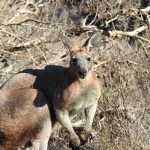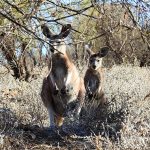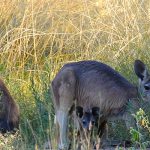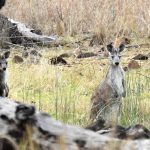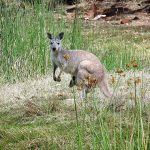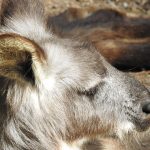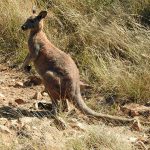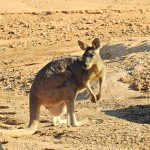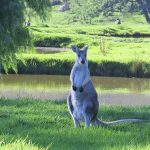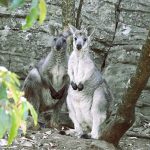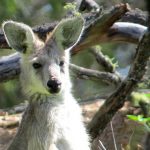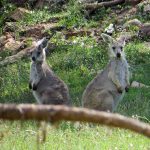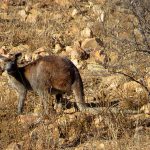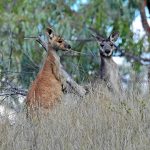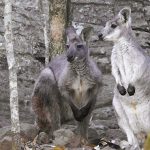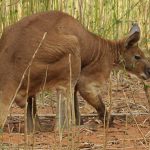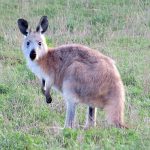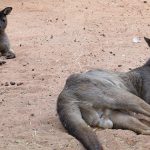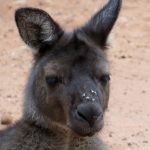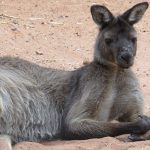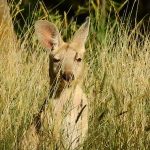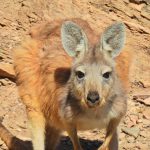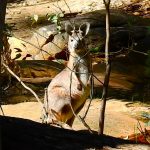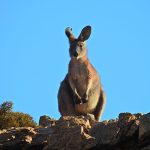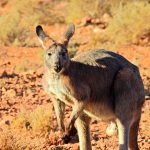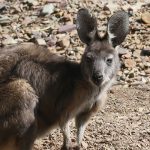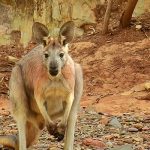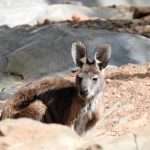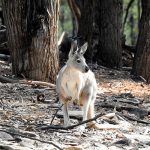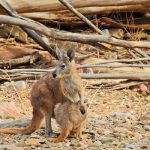WALLAROO
Australia’s Rugged Rock Dweller
Venture into the stony outcrops and craggy hillsides of Australia, and you might catch sight of a remarkable and often solitary figure—the Wallaroo, also known as the Euro. Stepping into its world is to witness a master in the art of survival, perfectly tuned to its demanding landscape.
Portrait of the Wallaroo
Let us pause and imagine the Wallaroo:
- A sturdy, medium-sized marsupial with a powerful, muscular build.
- A coat ranging from deep slate-grey (for males) to softer, lighter greys (for females).
- Bright, alert eyes scan the jagged shadows of rocky escarpments as strong hind legs perch delicately atop uneven stone.
Close your eyes for a moment and sense the tactile connection between the Wallaroo’s thick, padded feet and the rough granite beneath. Feel the warmth of the early sun striking its dense fur, offering both protection and camouflage against predators.
Habitat and Distribution
| Feature | Description |
|---|---|
| Preferred Habitat | Rocky outcrops, escarpments, hilly terrains |
| Range | Widespread—from central deserts to eastern coast hills |
| Distribution | One of Australia’s most common macropods in these zones |
Unlike kangaroos of open plains or wallabies of thick forests, Wallaroos are the masters of the margins, making their homes amongst the rocks where survival demands both strength and agility.
Diet: Adaptable Herbivore
The Wallaroo’s diet is a study in adaptation:
- Feeds primarily on tough grasses, leaves, and occasionally hardy shrubs.
- Alters its diet with the shifting of the seasons and the mood of the land.
- During long, dry stretches, will travel significant distances in search of moisture-laden feed.
Listen: Picture the gentle crunch of dry blades beneath powerful jaws, the soft rustle of shrubbery as the Wallaroo forages in the half-light of dusk.
Social Structure and Lifespan
An air of independence hangs around each Wallaroo:
- Prefers solitary lives, with only occasional gatherings in small, temporary groups when food is abundant.
- Lifespan: typically 15–20 years, resilient in the face of drought, predators, and the challenging Australian elements.
Unlike their larger kangaroo cousins, Wallaroos value solitude, establishing clear and enduring territories over their stony domains.
Physical Adaptations
Adaptations are written across the Wallaroo’s body:
- Powerful hind legs: for agile leaps across boulders and forceful blows in self-defence.
- Muscular tail: serves as a counterbalance on clifftops, a sturdy support when sitting upright.
- Dense fur: provides insulation against searing daytime heat and the chill of night.
Visualise: The silent, spring-loaded leap from one granite slab to another—an acrobat shaped by millennia of evolution.
Daily Rhythm
Wallaroos time their activity with the land’s natural cycles:
- Most active in the cool hours of dawn and dusk, when shadows lengthen and day’s heat wanes.
- During midday, they retreat to shaded crevices where the scent of dry earth and stone mingles.
Conservation Status and Challenges
| Status | Details |
|---|---|
| IUCN Red List | Least Concern |
| Key Threats | Habitat loss, hunting, changing land use |
Though widespread and numerous, the Wallaroo isn’t immune to the steady pressures of habitat encroachment and human activity. Every rocky refuge preserved is another chapter in their long story on this continent.
Cultural Significance
Wallaroos also dwell in the heart of human stories:
- Featured in the Dreamtime narratives of Indigenous Australians.
- Appear in timeless artwork, revered as symbols of strength and endurance.
Conclusion: Nature’s Rugged Survivor
The Wallaroo stands as a testament to resilience, an emblem of Australia’s demanding interior. To watch one move expertly across harsh, stony ground is to glimpse the ingenuity of nature—adapting, thriving, and persevering.
Conservation Message
Though common, the Wallaroo’s continued success is a gentle reminder: safeguarding diverse habitats ensures all creatures, familiar and rare, can stand on their chosen ground. By protecting these rocky sanctuaries, we honour a heritage shared between animal and land, woven through stories and survival.
Let us celebrate the Wallaroo—not just for its strength, but for the insight it offers into a world shaped by resilience and adapted to endure.

